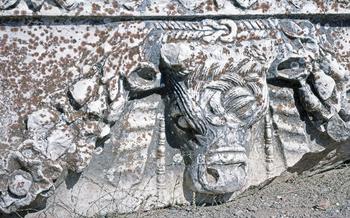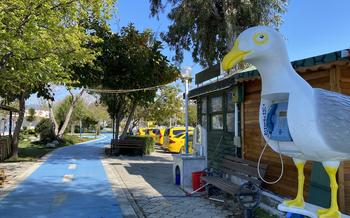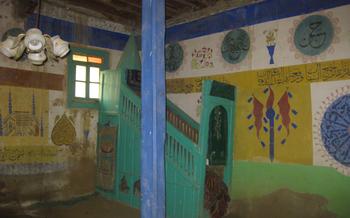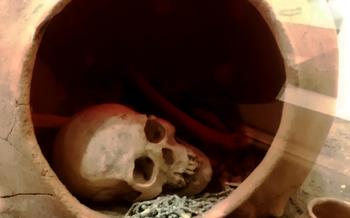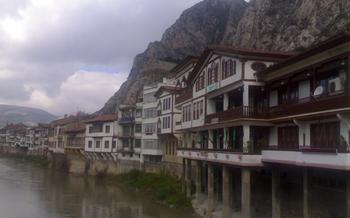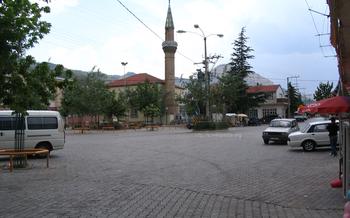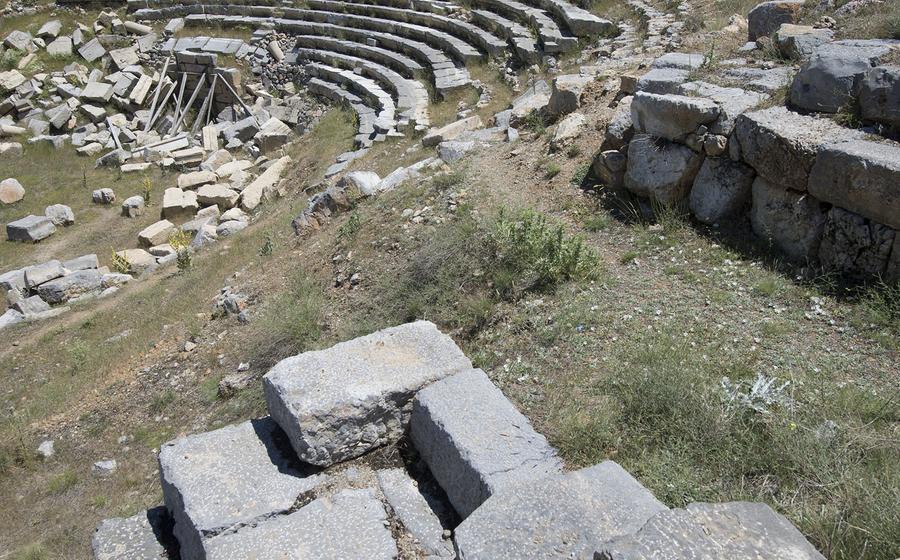
Antioch of Pisidia (Yalvaç)
- Antioch of Pisidia (Yalvaç)
- The City Walls
- The Theater
- The Odeon
- The Temple of Men
- The Aqueduct
- The Necropolis
- The Museum
- The Village of Yalvaç
- Other Nearby Attractions
- Best Time to Visit
- Accommodation Options
- Food and Drink
- Shopping
- Insider Tip
Antioch of Pisidia (Yalvaç)
**Antioch of Pis Isparta province of Turkey. Founded in the 3rd century BC by Antiochus III the Great, it was a significant city in the Roman province of Pisidia. The city served as a major center of Christianity and was visited by the Apostle Paul during his missionary journeys. Antioch of Pisidia reached its peak during the Roman period, boasting impressive architecture, theaters, temples, and an aqueduct. Today, the ruins of this ancient city offer a glimpse into its rich history and cultural heritage.
To get to Antioch of Pisidia, one can take a bus or rent a car from the city of Isparta. The drive takes approximately 5 hours, and the road is well-maintained. The entrance fee to the site is minimal, and it is open to visitors during daylight hours.
The City Walls
The imposing city walls of Antioch of Pisidia (Yalvaç) stand as a testament to the city's strategic importance and architectural prowess. Originally constructed to defend against potential invaders, these fortifications played a crucial role in protecting the city throughout its history.
Explore the well-preserved sections of the walls, marveling at their intricate construction and impressive height. Look for unique features such as towers, gates, and bastions, which provided additional defense mechanisms. As you walk along the ramparts, take a moment to appreciate the stunning panoramic views of the surrounding landscape, offering a glimpse into the city's past and present.
The Theater
Discover the well-preserved theater, one of the largest in the region
Among the impressive ruins of Antioch of Pisidia, the theater stands out as a testament to the city's cultural and artistic heritage. Built in the 2nd century AD, this magnificent structure could accommodate up to 15,000 spectators, making it one of the largest theaters in the region. Despite the ravages of time, much of the theater remains intact, offering visitors a glimpse into the grandeur of ancient performances.
Capacity, acoustics, and stage design
The theater's vast seating capacity allowed for a diverse range of performances, from dramatic plays to musical concerts. The acoustics were carefully engineered to ensure that even those seated in the highest rows could clearly hear the actors' voices. The stage, adorned with elaborate decorations and sculptures, provided a grand backdrop for the performances.
Ongoing restoration efforts and future plans
In recent years, the theater has undergone extensive restoration efforts to preserve its structural integrity and enhance its accessibility. These efforts have included the reconstruction of damaged seating rows, the installation of new lighting systems, and the creation of pathways for visitors to safely explore the site. Plans are also underway to develop an interpretive center that will provide visitors with more information about the theater's history and significance.
The Odeon
In addition to the grand theater, Antioch of Pisidia also boasts a smaller theater known as the Odeon. While not as large as its counterpart, the Odeon served a distinct purpose, primarily hosting musical performances and other intimate events. Its smaller size allowed for better acoustics, creating an ideal setting for musicians and singers to showcase their talents.
Unlike the main theater, the Odeon was not used for dramatic performances or public assemblies. Instead, it catered to a more select audience, offering a more intimate and immersive experience. While the Odeon may not be as impressive in terms of size, its unique character and historical significance make it a must-visit for those interested in the cultural and artistic aspects of ancient Antioch.
Unfortunately, the Odeon has not been as well-preserved as the main theater and is currently in a state of disrepair. Despite its dilapidated condition, visitors can still appreciate its architectural features and imagine the vibrant atmosphere that once filled this small theater.
The Temple of Men
Among the ruins of Antioch of Pisidia, the Temple of Men stands as a testament to the religious beliefs and imperial connections of the ancient city. Dedicated to the Greco-Roman god Men, who was revered as a protector and healer, the temple held a significant position in the urban landscape.
Built in the 2nd century AD, the temple showcased a blend of architectural styles. Its facade featured a series of columns topped with ornate capitals, while the interior boasted a cella, or inner sanctuary, where a cult statue of Men may have been housed. Inscriptions discovered at the site suggest that the temple was dedicated during the reign of the Roman emperor Septimius Severus.
The Temple of Men served as a center of religious worship and imperial cult practices. It reflected the influence of Roman rule and the integration of local beliefs with Roman religious traditions. Visitors to the ruins can admire the architectural details and imagine the rituals and ceremonies that once took place within the temple's sacred walls.
The Aqueduct
One of the most impressive feats of engineering in ancient Antioch was its aqueduct, which supplied water to the city from a distant source. Constructed using stone and mortar, the aqueduct stretched for several kilometers and traversed rugged terrain, showcasing the ingenuity of Roman engineers.
The aqueduct's construction involved careful planning and precision, as it had to maintain a consistent gradient to ensure the flow of water. Along its course, the aqueduct featured arched sections that allowed it to cross ravines and valleys, demonstrating the advanced architectural techniques employed by the Romans.
While much of the aqueduct has succumbed to the passage of time, substantial portions remain visible, offering a glimpse into the city's intricate water management system. Visitors can admire the sturdy stone arches and marvel at the sheer scale of this engineering marvel, which played a crucial role in sustaining life in ancient Antioch.
The Necropolis
Outside the city walls, discover the ancient necropolis, a poignant reminder of Antioch of Pisidia's past inhabitants. Stroll among the variety of tombs, each telling a unique story of life and death in this ancient city. From simple graves to elaborate mausoleums, these burial sites provide a glimpse into the diverse customs and beliefs of the people who once called Antioch home. Explore the different types of tombs, including rock-cut chambers, sarcophagi, and tumuli, and learn about the fascinating burial practices and rituals that were once performed here. The necropolis offers a profound connection to the lives and legacies of those who shaped Antioch's rich history and serves as a reminder of the enduring power of memory and tradition.
The Museum
The Yalvaç Museum, also known as the Pisidian Antioch Museum, is a treasure trove of history and artifacts that offers a deeper insight into the ancient city and the surrounding region. Housed in a modern building on the outskirts of the village, the museum features a collection that spans various periods, from the Neolithic era to the Ottoman Empire.
Among the highlights of the collection are intricate mosaics depicting scenes from mythology and daily life. These stunning artworks provide a glimpse into the artistic prowess of the ancient inhabitants of Antioch of Pisidia. The museum also houses a collection of sculptures, including statues of gods, goddesses, and prominent figures from antiquity. These sculptures offer a tangible connection to the past and shed light on the religious beliefs and cultural practices of the ancient Pisidians.
In addition to mosaics and sculptures, the museum displays a variety of inscriptions and pottery shards that provide valuable information about the history and administration of the city. These artifacts offer insights into the economic, social, and political structures of Antioch of Pisidia and help piece together the story of this ancient metropolis.
The Yalvaç Museum is a must-visit for anyone interested in the history and culture of Antioch of Pisidia. Its collection offers a comprehensive overview of the city's past and provides a deeper appreciation for its significance in the ancient world.
The Village of Yalvaç
Nestled amidst the ruins of ancient Antioch, the modern-day village of Yalvaç exudes a charm that seamlessly blends the past and present. Once a bustling metropolis, Yalvaç now serves as a welcoming host to visitors seeking to delve into the depths of history and culture.
As you wander through the village, the echoes of antiquity linger in the air, inviting you to explore the remnants of bygone eras. Locals, with their warm smiles and open arms, embrace visitors with a hospitality that epitomizes Turkish culture.
Yalvaç presents a unique opportunity to immerse yourself in the local way of life. Engage in lively conversations with villagers, savor the flavors of traditional cuisine at family-run restaurants, and discover hidden gems that only locals know about.
Whether you seek solace in nature or prefer to explore the vibrant streets, Yalvaç offers a diverse range of experiences. Stroll along the scenic riverside promenade, where the gentle murmur of water creates a tranquil ambiance. For a taste of local traditions, visit the weekly market, where vendors display an array of fresh produce, handmade crafts, and local delicacies.
Don't miss the chance to stay overnight in Yalvaç and immerse yourself in the village's charm. Choose from a variety of accommodation options, from cozy guesthouses to charming hotels, each offering a unique perspective on this historic destination.
From the moment you arrive in Yalvaç, you'll be captivated by its authenticity and warmth. Embrace the opportunity to connect with the locals, learn about their customs, and create memories that will last a lifetime.
Other Nearby Attractions
In addition to the captivating ruins of Antioch of Pisidia, the region offers a treasure trove of other ancient sites and natural wonders. Just a short distance away, visitors can delve into history at the Pisidian Antioch Archaeological Museum, which houses a remarkable collection of artifacts unearthed from the ancient city.
Nature enthusiasts will delight in exploring the pristine beauty of Kovada Lake, a mesmerizing natural wonder known for its crystal-clear waters and lush surroundings. Take a leisurely stroll along the lakeshore, marvel at the diverse birdlife, or embark on a peaceful boat ride to soak in the tranquility of this hidden gem.
For those seeking further aquatic adventures, Eğirdir Lake beckons with its pristine waters and picturesque landscapes. Immerse yourself in the lake's refreshing embrace, embark on a scenic boat tour, or simply relax on its shores and revel in the breathtaking views.
Best Time to Visit
Timing your visit to Antioch of Pisidia is crucial for a pleasant and enriching experience. The region experiences a Mediterranean climate, characterized by hot, dry summers and mild, rainy winters.
The ideal time to visit is during the shoulder seasons, from April to May and from September to October. During these months, the weather is generally warm and sunny, with comfortable temperatures for exploring the ruins and engaging in outdoor activities.
Summer months, particularly July and August, can be scorching, with temperatures often exceeding 35 degrees Celsius. While the heat may not deter some visitors, it's important to be prepared for the intense sun and take necessary precautions, such as staying hydrated, wearing sunscreens, and seeking shade during the hottest hours of the day.
Winter, on the other hand, brings cooler temperatures and occasional rainfall. While the ruins remain accessible, the weather conditions may not be ideal for extended outdoor exploration. However, if you're interested in avoiding the crowds and experiencing a more tranquil atmosphere, winter can be a good time to visit.
To ensure a hassle-free and enjoyable visit, it's advisable to check the weather forecast before your trip and plan accordingly. Additionally, consider packing layers of clothing to adapt to the changing temperatures, especially if you're visiting during the shoulder seasons.
Accommodation Options
When planning your stay in Yalvaç, you'll find a range of accommodation options to suit different budgets and preferences. From budget-friendly guesthouses to comfortable hotels, there's something for every traveler.
For a truly immersive experience, consider staying in a traditional Turkish guesthouse. These cozy establishments often offer a glimpse into local life and culture, with warm hospitality and home-cooked meals. Prices typically start around 20-30 euros per night.
If you prefer the comforts of a modern hotel, several options are available in Yalvaç. These hotels offer a range of amenities, including air conditioning, private bathrooms, and Wi-Fi. Prices start around 40-50 euros per night.
For those seeking a unique and luxurious experience, consider staying at the Eğirdir Gölü Oteli. This lakeside resort offers stunning views of Eğirdir Lake and the surrounding mountains. Guests can enjoy a variety of amenities, including a private beach, a spa, and several restaurants. Prices start around 100 euros per night.
No matter your budget or preferences, you're sure to find a comfortable and welcoming place to stay in Yalvaç.
Food and Drink
Indulge in the delectable flavors of the region and savor the culinary delights that Yalvaç has to offer. Begin your gastronomic journey by trying the mouthwatering "keşkek", a traditional Anatolian dish made from wheat, meat, and spices, cooked slowly in a clay pot. For a taste of local street food, sample the crispy "gözleme", a flatbread filled with various fillings such as cheese, spinach, or potatoes.
Vegetarians will find a haven in Yalvaç, with an array of meat-free options to choose from. Delight in the fresh and tangy flavors of "cacık", a yogurt-based sauce served with cucumbers and garlic. Sample the savory "pişi", a deep-fried dough often enjoyed with honey or jam.
When it comes to drinks, quench your thirst with "ayran", a refreshing yogurt beverage that perfectly complements the local cuisine. Coffee lovers can sip on a strong cup of Turkish coffee, a symbol of hospitality and an integral part of the Turkish culture.
For a unique dining experience, head to one of the local restaurants that serve traditional Turkish dishes prepared with fresh, seasonal ingredients. Whether you prefer a cozy family-run eatery or a more upscale establishment, you're sure to find something to satisfy your taste buds.
Remember to embrace the local customs and traditions when dining out. Show your appreciation for the food by saying "afiyet olsun" (bon appétit) before starting your meal. If you're unsure about the menu or have any special requests, don't hesitate to ask the friendly staff for assistance.
Shopping
The village of Yalvaç offers a delightful shopping experience, where you can discover unique souvenirs and handicrafts that reflect the rich cultural heritage of the region. Stroll through the vibrant local markets and explore the charming shops that line the narrow streets. From handwoven rugs and intricate pottery to traditional jewelry and decorative items, there's something for every taste and budget.
When shopping in Yalvaç, don't hesitate to engage with the friendly locals and learn about the stories behind the products. They'll be more than happy to share their knowledge and help you find the perfect memento of your visit. And remember, bargaining is a part of the local culture, so don't be afraid to negotiate a fair price. Just be respectful and mindful of the artisans' time and effort.
To ensure ethical shopping practices, look for products that are locally made and support the livelihoods of the artisans. Many shops display signs indicating that they sell handmade goods, and you can also ask the vendors directly about the origin of their products. By choosing to shop locally, you not only take home a piece of Yalvaç but also contribute to the preservation of traditional crafts and support the local economy.
Insider Tip
-
Plan to spend at least half a day exploring the ruins of Antioch of Pisidia. This will give you enough time to see all the major attractions, including the city walls, the theater, the odeon, the Temple of Men, the aqueduct, and the necropolis.
-
Pack comfortable shoes and sun protection, as the site is mostly uncovered. The sun can be intense in Turkey, so it's important to protect yourself from the heat.
-
Consider hiring a local guide for a more in-depth and informative experience. A guide can help you understand the history and significance of the ruins and point out details that you might otherwise miss.


